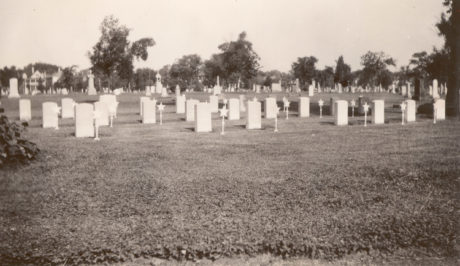By Sue Hunter Weir

Bad things can happen to people for any number of reasons. Some people make bad decisions. Others simply have bad luck. Arthur Pruitt may well be one of the unluckiest people buried in the cemetery. The last ten years of his life was a series of tragedies, all of them beyond his control.
Arthur Pruitt was born in Kentucky sometime around 1837. He married Irene Elizabeth Tribble in Scott, Illinois on May 21, 1857. On May 7, 1864, he enlisted in Company B of the 27th Illinois Infantry. He signed on for 100 days. His military records state that he was 28 years old, that he was 5 feet 8 inches tall, and had light hair and blue eyes.
Three months after he enlisted. he was captured and sent to Andersonville Prison, the worst prisoner of war camp during the Civil War. Of the 45,000 men held captive there, 13,000 died from malnutrition and disease. He was released in a prisoner exchange on April 1, 1865.
After the war, he and his wife settled in Memphis and that is when the first in what would turn out to be a series of heartbreaking losses began. Their children died during a yellow fever epidemic. Soon after, their house containing everything that they owned was destroyed by fire. They left Memphis in late 1873 and moved to Minnesota with an eye to starting over. Irene had relatives in Long Lake who had promised to help them but there was some misunderstanding. By the time that the couple arrived, the people who they were counting on to help them had moved to Missouri. Arthur found work and he and his wife stayed in Long Lake until February 6th when they came to Minneapolis. They met a veteran who offered Arthur work, and on February 7th, they boarded a train to St. Paul where Arthur was going to start his new job.
The train was overcrowded and there were no seats in the passenger cars. Arthur told his wife that he was going to go to the baggage car to find a place to sit down. As the train was crossing from Nicollet Island to the east side of the Mississippi, he stepped out onto the platform connecting the cars, lost his balance and fell onto the frozen river below. He died instantly. The coroner ruled it an accidental death and ordered that Arthur be buried in what was then called Layman’s Cemetery at the county’s expense.
His wife was reported to be “in great affliction.” She had lost her children, her home and finally her husband. She was “…left alone in a strange country with scarcely any money” and the paper urged the “benevolent…not to forget her case.” And the benevolent did step up. Mr. A. Murphy, described as a “laboring man”, circulated a subscription paper and raised $40.00 in small amounts. One benefactor didn’t have any money but donated a half-pound of tea. Another man who he approached “declined to give anything,” and treated Mr. Murphy “in the most insulting manner.” The Tribune didn’t name the man but probably didn’t need to since readers would know who the man that the paper described as the “agent of the St. Paul and Pacific Railroad in the East Division” was.
After her husband died, Mrs. Pruitt went back to Long Lake and stayed with friends that she and her husband had met during the six weeks that they had stayed there. Where she went after that is unknown.
Arthur Pruitt was buried in Section H, the paupers’ section of the cemetery on February 9, 1874, and that’s something of a puzzle. The Grand Army of the Republic had purchased a block of graves in 1871 in order to prevent veterans from being buried as paupers. Why he was not buried in one of those graves is not clear. He has been buried in an unmarked grave for 148 years, something that we will correct when we order a military marker for him.









